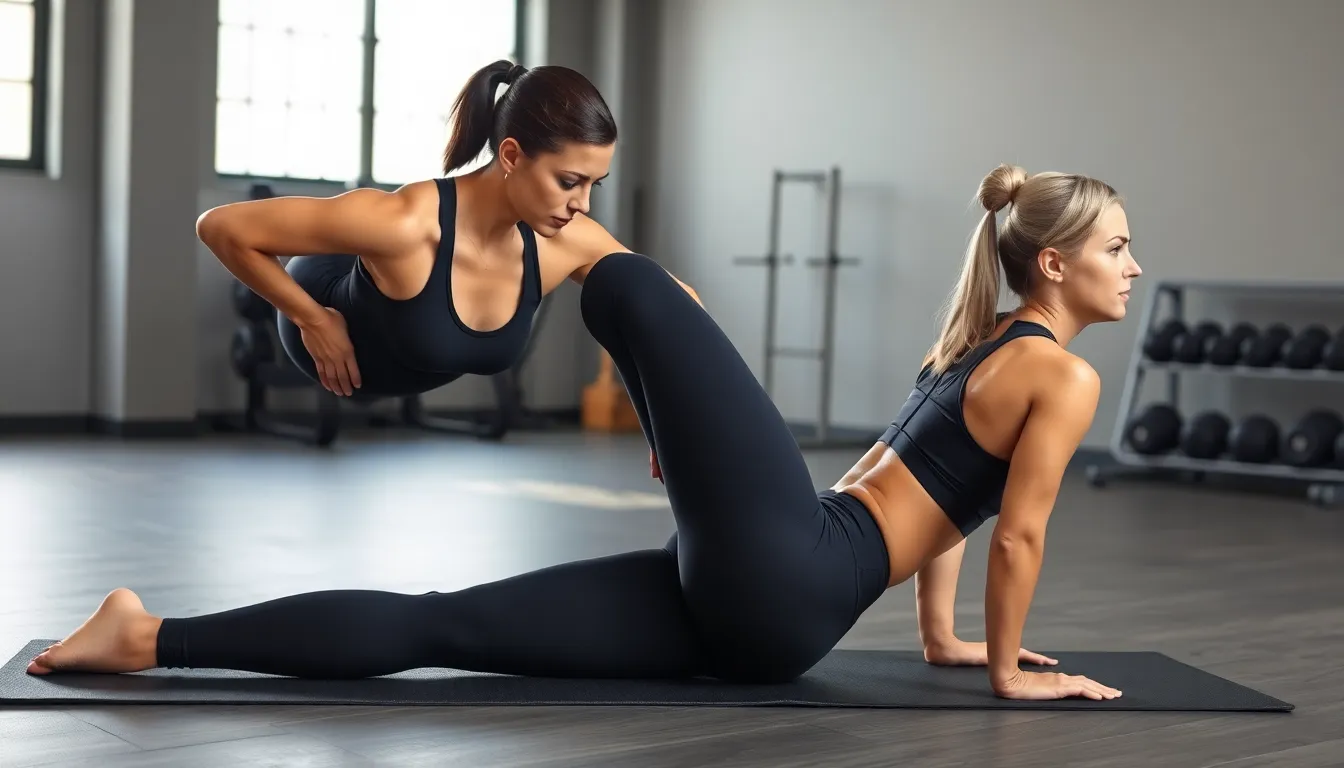Table of Contents
ToggleUnderstanding anterior pelvic tilt is crucial for many women seeking to improve their posture and overall health. This common condition can lead to discomfort and affect daily activities. By examining the before and after effects of addressing anterior pelvic tilt, individuals can gain insight into the transformative power of targeted exercises and lifestyle changes.
The journey from awareness to action can significantly enhance physical well-being. Women often find that correcting anterior pelvic tilt not only alleviates pain but also boosts confidence and improves body mechanics. This article explores the remarkable differences women experience when they embrace corrective measures, showcasing real-life examples and expert insights.
Overview of Anterior Pelvic Tilt
Anterior pelvic tilt (APT) occurs when the pelvis tilts forward, leading to an exaggerated lumbar curve. This condition often stems from muscular imbalances, particularly tight hip flexors and weak glutes and abdominal muscles.
Notably, APT impacts women frequently, affecting their posture, gait, and physical performance. Symptoms include lower back pain, hip discomfort, and reduced mobility. Addressing these issues isn’t merely cosmetic; it contributes significantly to overall health and well-being.
Corrective measures include specific exercises targeting posture stabilization and muscle strengthening. For instance, incorporating stretches for the hip flexors and strengthening activities for the glutes can restore balance.
The positive outcomes of addressing APT can be substantial, with many women reporting enhanced posture, reduced pain, and greater confidence in their daily activities. Adopting a holistic approach, integrating body awareness and lifestyle adjustments, supports long-term success in managing and improving anterior pelvic tilt.
Causes of Anterior Pelvic Tilt


Anterior pelvic tilt (APT) arises from various factors, primarily linked to postural habits and muscle imbalances. Identifying these causes helps in implementing effective corrective measures.
Postural Factors
Postural factors significantly contribute to APT. Prolonged sitting, especially with poor ergonomics, promotes a forward tilt in the pelvis. Office workers and individuals with sedentary lifestyles often adopt a slouched position, enhancing the lumbar curve. Additionally, excessive screen time encourages poor posture, leading to compensatory muscle adjustments. Regular awareness and adjustments to posture can mitigate these effects.
Muscle Imbalances
Muscle imbalances play a crucial role in the development of APT. Tight hip flexors, commonly developed through prolonged sitting, pull the pelvis forward. Weak glute muscles fail to counteract this pull, allowing the pelvis to maintain an exaggerated position. Abdominal muscles that are underactive can further exacerbate this issue. Strengthening the glutes and core, along with stretching the hip flexors, effectively addresses these imbalances, promoting better pelvic alignment.
Effects of Anterior Pelvic Tilt on Women
Anterior pelvic tilt significantly affects women, impacting both physical health and emotional well-being. Understanding these effects aids in recognizing the importance of addressing APT.
Physical Implications
Anterior pelvic tilt contributes to various physical issues. Muscular imbalances can result in tight hip flexors, leading to discomfort in the lower back and hips. It often creates an exaggerated lumbar curve, increasing the risk of injury during physical activities.
Pain becomes a common symptom, with many experiencing chronic lower back discomfort. APT may affect mobility, making movements like bending and squatting difficult. Over time, the condition can lead to decreased athletic performance and reduced functional capacity in everyday tasks. Corrective exercises targeting the glutes, hamstrings, and core can alleviate these physical symptoms and restore proper pelvic alignment.
Emotional Well-Being
The emotional impact of anterior pelvic tilt often goes overlooked. Physical pain associated with APT can contribute to feelings of frustration and low self-esteem. Women may experience anxiety related to body image and posture, impacting their confidence levels in social or professional environments.
Improvements in posture through targeted exercise can enhance self-perception, fostering a sense of empowerment. Engaging in corrective measures not only addresses physical discomfort but also promotes emotional resilience. Increased body awareness helps shift focus from pain to strength, positively influencing mental health and overall quality of life.
Before and After Transformations
Understanding the transformations associated with anterior pelvic tilt (APT) involves evaluating assessment techniques and learning from success stories. These elements showcase the significant improvements women can achieve by addressing APT.
Assessment Techniques
Effective assessment techniques are vital for diagnosing APT accurately. Professionals often use several methods:
- Postural Analysis: Observing the client’s standing posture provides insight into hip alignment and spinal curvature.
- Functional Movement Screening: This approach assesses movement patterns to identify compensations linked to muscle imbalances.
- Range of Motion Tests: Measuring flexibility and mobility in the hips and lower back helps pinpoint restrictions.
- Strength Assessments: Evaluating the strength of core, glute, and hip flexor muscles indicates areas needing attention.
Identifying these aspects enables targeted intervention strategies to correct APT.
Success Stories
Success stories illustrate the powerful transformations possible through dedicated efforts. Women experiencing APT often report visible and functional improvements, including:
- Increased Mobility: Many regain range of motion, making daily activities easier and more comfortable.
- Pain Reduction: A significant decrease in lower back pain is common, allowing for improved quality of life.
- Enhanced Posture: Participants note noticeable changes in posture, contributing to greater confidence in social and professional settings.
- Stronger Core and Glutes: Strengthening these areas facilitates better body mechanics, reducing the risk of future discomfort.
These success stories emphasize the importance of consistent practice and tailored programs in achieving lasting change.
Recommendations for Correction
Addressing anterior pelvic tilt (APT) requires a multifaceted approach, combining exercise strategies and lifestyle modifications. Implementing these recommendations enhances posture, alleviates discomfort, and promotes overall well-being.
Exercise Strategies
- Strengthen Glutes: Perform exercises such as glute bridges and hip thrusts to activate and strengthen gluteal muscles. Strong glutes support pelvic alignment and counteract tight hip flexors.
- Engage Core: Incorporate planks and dead bugs into routines. Strengthening the core muscles stabilizes the pelvis, making it less likely to tilt forward.
- Stretch Hip Flexors: Utilize standing quad stretches and lunges to elongate tight hip flexors. Regular stretching mitigates the pull on the pelvis, reducing its forward tilt.
- Promote Hamstring Flexibility: Include hamstring stretches like seated forward bends to improve flexibility. Balanced muscles around the pelvis foster better alignment.
- Corrective Postural Exercises: Integrate wall angels and pelvic tilts into exercise regimens. These movements encourage awareness of pelvic positioning and help reinforce proper posture.
Lifestyle Modifications
- Adjust Sitting Posture: Ensure that the workspace is ergonomically designed. Sitting with feet flat and knees at hip level lessens strain on the pelvis.
- Take Movement Breaks: Engage in short activity breaks every 30-60 minutes to stand or walk. Frequent movement decreases the risk of prolonged sitting, which contributes to APT.
- Limit Screen Time: Reduce time spent on devices with poor posture. Encouraging better body mechanics during screen use can mitigate muscle imbalances.
- Incorporate Regular Physical Activity: Participate in activities such as walking, swimming, or cycling. Regular exercise boosts overall muscle strength and stability, supporting pelvic alignment.
- Be Mindful of Body Awareness: Practice mindfulness techniques focusing on posture throughout daily activities. Improved body awareness supports long-term correction of APT.





